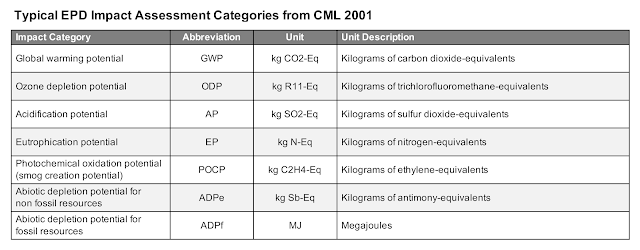A life-cycle impact assessment (LCIA) essentially serves as the "what does it mean" step in the broader process of conducting a life-cycle assessment (LCA) for a product or material.
Through an LCIA, the data from the life-cycle inventory (think data-collection component of an LCA) is assessed in terms of various environmental impacts. The results of the assessment are often reported based on one of several standardized methodologies for categorizing and characterizing the life-cycle impacts. Among several widely recognized methodologies for conducting an LCIA, two of the most common utilized for building products today are CML and TRACI.
CML vs TRACI methodologies
The CML methodology, developed by the Institute of Environmental Sciences at the University of Leiden in the Netherlands, is the most widely used, and often considered the most complete, of the LCIA methodologies. It uses primarily European data to derive its environmental impact factors.
The TRACI, or “Tool for the Reduction and Assessment of Chemical and Other Environmental Impacts," methodology is an impact assessment methodology developed by the U.S. Environmental Protection Agency. It differs from the CML methodology in that the data comes primarily from North American sources. However, the TRACI methodology is not as comprehensive or complete as the CML method.
If one were to pull an environmental product declaration (EPD), they may find tabulated "environmental impact potentials" for both CML and TRACI - and the categories, abbreviations, and units offered can be confounding.
The following is a brief definition of the major environmental impact assessment categories and how CML 2001 and TRACI 2.1 measure each.
Global warming potential (GWP)
GWP indicates the global warming potential of all greenhouse gasses that are recognized by the Intergovernmental Panel on Climate Change (IPCC).
The characterization model scales substances that include methane and nitrous oxide to the common unit of kilograms of carbon dioxide-equivalents (kg of CO2-Eq) for both the CML and TRACI methodologies.
Ozone depletion potential (ODP)
ODP indicates the potential impact of all substances that contribute to stratospheric ozone depletion.
The characterization model scales substances that include chlorofluorocarbon, hydrochlorofluorocarbon, chlorine, and bromine to the common unit of kilograms of trichlorofluoromethane-equivalents.
- CML lists kilograms of R11 equivalents (kg R-11-Eq)
- TRACI lists kilograms of CFC 11 equivalents (kg CFC-11-Eq)
Acidification potential (AP)
AP indicates the the potential impacts of all substances that include sulfur oxides, nitrogen oxides, and ammonia.
The characterization model scales substances to the common unit of kilograms of sulfur dioxide-equivalents (kg SO2-Eq) for both the CML and TRACI methodologies.
Eutrophication potential (EP)
EP indicates the potential impacts of all substances that contribute to eutrophication (i.e., excessive richness of nutrients in a lake or other body of water) potential.
The characterization model scales substances that include nitrates and phosphates to the common unit of kilograms of nitrogen-equivalents (kg of N-Eq) for both the CML and TRACI methodologies.
Photochemical oxidation potential (POCP) / smog forming potential (SFP)
Regarding the potential impacts of all substances that contribute to photochemical smog potential, CML and TRACI use two different categorical names and associated units.
For CML, the category of POCP is used and the characterization model scales substances that include nitrogen oxides and volatile organic compounds to the common unit of kilograms of ethylene-equivalents (kg C2H4-Eq).
For TRACI, the category of SFP is used and the characterization model scales substances that include nitrogen oxides and volatile organic compounds to the common unit of kilograms of ozone-equivalents (kg O3-Eq).
Abiotic depletion potential (ADP) / fossil fuel depletion
ADP indicates the potential impact of reducing the global amount of non-renewable raw materials and is determined for each extraction of minerals and fossil fuels based on the remaining reserves and rate of extraction. CML distinguishes between non-fossil resources (APDe) and fossil resources (ADPf).
- CML lists ADPe as kilograms of antimony-equivalents (kg Sb-Eq) and ADPf as megajoules (MJ)
- TRACI lists ADP as megajoules (MJ)
Table 1: Typical environmental product declaration (EPD) impact assessment categories from the CML 2001 methodology. Table by Daniel Overbey. |
Table 2: Typical environmental product declaration (EPD) impact assessment categories from the TRACE 2.1 methodology. Table by Daniel Overbey. |
But wait, there's more
Although these categories are among the most listed in an EPD, the CML and TRACI methodologies incorporate a range of additional indicators. As our industry advances frameworks and tools to consider the global warming potential of building products and materials, the design and construction industry should consider these additional impact assessment categories and the other indicators produced by the CML and TRACI methodologies in order to better understand the range of impacts of our projects.




Recent Comments
These are actually very helpful tips. It is...
This is the most beneficial blog for all...
This blog is a great resource for anyone...
Thank you for sharing this important information. I...
This is a very interesting subject of the...